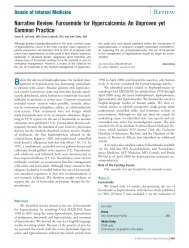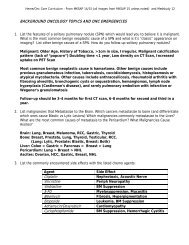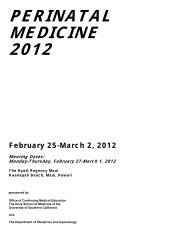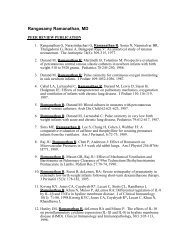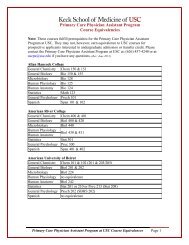Program Book - Keck School of Medicine of USC - University of ...
Program Book - Keck School of Medicine of USC - University of ...
Program Book - Keck School of Medicine of USC - University of ...
- No tags were found...
You also want an ePaper? Increase the reach of your titles
YUMPU automatically turns print PDFs into web optimized ePapers that Google loves.
within the peripheral circulation, but also within the total system. In the simplest termsthe bypass graft functions as a low-resistance collateral in parallel circuitry (Fig. 4B).Recalling that the inverse <strong>of</strong> the total resistance <strong>of</strong> a parallel circuit is the sum <strong>of</strong> theinverse <strong>of</strong> the individual resistors, 1/Rtotal = 1/R1 1 1/R2 the total resistance <strong>of</strong> the parallelcircuit is always lower than that <strong>of</strong> each individual resistor. By reducing the ratios <strong>of</strong>resistance between the systemic circulation and the fistula, the brachial shunt fraction isdecreased and peripheral perfusion is augmented. The overall reduction in resistance inthe system augments the total blood flow in the extremity such that fistula blood flowsare maintained. If a distal bypass graft were performed without concomitant ligation <strong>of</strong>the artery distal to the fistula, it could certainly augment the retrograde flow in the distalbrachial artery. In the face <strong>of</strong> ligation the blood flow is left with no other choice but t<strong>of</strong>ollow the pressure gradient downstream to the peripheral vascular bed. Some vascularsurgeons remained concerned about ligating the artery below the fistula origin, but inpractice, this component <strong>of</strong> the procedure rarely leads to significant adverse sequelae.Figure 4.Key points to DRIL procedure:1. Use autogenous vein whenever possible2. Exclude inflow stenosis before proceeding with DRIL procedure3. Originate the bypass well proximal to the pressure sink zone near the AVF origin.In practice, this might need to be at least 5-10 cm. In an upper extremity fistula,there is a continuous drop <strong>of</strong>f in arterial pressure from the origin <strong>of</strong> the ipsilateralsubclavian artery to the large pressure sink zone at the origin <strong>of</strong> the fistula itself.If the bypass is originated too close to the pressure sink zone, the inflow will beinadequate to restore adequate distal perfusion (somewhat analogous to1178



